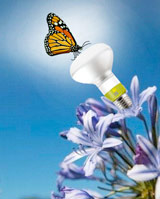Need an energy-efficient bulb for your new home lighting project? Chances are you’ll end up choosing between a compact fluorescent bulb (CFL) or a light-emitting diode (LED). By and large, these two product families have had a lock on the energy-efficient lighting market -- but that's poised to change. An innovative startup company called Vu1 has been quietly developing an alternative technology, and the lighting industry might be on the verge of a genuine shakeup.
Vu1's new technology is called electron-stimulated luminescence (ESL™); it received an official trademark from the U.S. Patent and Trademark Office on June 27, 2008. As the company’s executives describe it, the process uses accelerated electrons to stimulate a phosphor coating on the inside of a standard glass light bulb. The technology causes the surface of the glass bulb itself to glow and emit light; this is different than incandescent bulbs, which run a current through a filament inside the bulb, and LED lighting, which stimulate semiconductors to produce light. Vu1 execs say they're expecting their first prototype to output about 40 lumens per watt with a lifetime of about 6,000 hours.
The new technology is remarkable because it isn't a variation of either CFL or LED lighting mechanics. Instead, it purports to be an entirely new technology -- and Vu1 hasn't wasted any time highlighting this difference. The company, formerly known as Telegen Corp., spent four years and more than $4.5 million developing the technology. Before that, it was a struggling electronics firm that watched its stock slowly sink in the aftermath of the dot-com boom. In 2004, with bankruptcy looming, shareholders installed a new executive board, which then set about trying to salvage something from the troubled company's intellectual assets. When inspiration finally struck, it came in the form of -- what else? -- a light bulb.
“[The shareholders] stumbled over an ability to produce light in a residential application,” says Ron Davis, Chief Marketing Officer of Vu1. “They basically pulled the company out of bankruptcy and relaunched it four years ago. We threw away everything we had done [and] decided to produce a new light source.”
Renamed Vu1, the company has hung its commercial future on the success or failure of next-generation lighting. And with consumers moving slowly to embrace CFLs and LED lighting, the new company has moved quickly to offer the best of both products.
“What we're targeting to bring to market in the first quarter of 2009 is an energy-efficient, mercury-free, totally nontoxic household disposable,” Davis told Residential Lighting in July. The new bulb will be fully dimmable with instant-on capability and should interface seamlessly with existing lighting controls. The company's first batch of products will be reflector bulbs intended for use in recessed cans and floodlights.
Two prominent lighting research laboratories contacted recently said they couldn't offer comment about Vu1’s products because the technology is so new.
The company hopes to position its ESL™ bulbs as cleaner than CFLs (with their trace amounts of mercury) and greener than LEDs (which require substantial energy to manufacture). The $12 price tag puts the new bulbs on par with the average price for a dimmable CFL. The first screw-in models could be available as early as September 2008, and Davis says Vu1's manufacturing facility in the Czech Republic is capable of churning out several million ESL™ bulbs in the first year of business.

